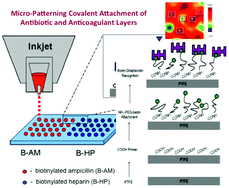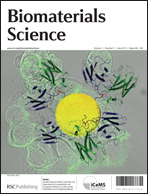Formation of heterogeneous and controllable surface patterns on polymeric materials containing antimicrobial and anticoagulant components represent an attractive way of maintaining synthetic materials “clean” from adverse bio-activities. The primary surface “contaminants” are microbial films as well as blood coagulation, both affecting not only performance of internal or external devices, but often exhibiting detrimental effects on patients. In an effort to simultaneously inhibit formation of microbial films and surface blood coagulation multifunctional assemblies containing streptavidin (STR)–biotin bioconjugates were developed on poly(tetrafluoroethylene) (PTFE) surfaces. Using STR conjugated to a biotin-functionalized PTFE surface, spatially controlled micro-patterning was produced by grafting biotinylated polyethylene glycol (B-PEG) to COOH modified PTFE (MA-PTFE), followed by inkjet micro-printing of biotinylated ampicillin (B-AM) and biotinylated heparin (B-HP) molecules. These surfaces exhibit simultaneous antimicrobial and anticoagulant attributes manifested by “zone of inhibition” and anticoagulant measurements. Quantitative spectroscopic analysis revealed that the required surface density of COOH groups on PTFE is 2.94 × 10−7 g cm−2, and B-PEG and STR densities of 9.2 × 10−8 g cm−2 and 3.5 × 10−8 g cm−2, respectively, are sufficient to achieve simultaneous antimicrobial and anticoagulant responses. These studies also showed that the force required to remove STR–biotin conjugates attached to PTFE surfaces measured by atomic force microscopy is approximately 1090 pN, thus providing desirable surface mechanical stability.

You have access to this article
 Please wait while we load your content...
Something went wrong. Try again?
Please wait while we load your content...
Something went wrong. Try again?


 Please wait while we load your content...
Please wait while we load your content...